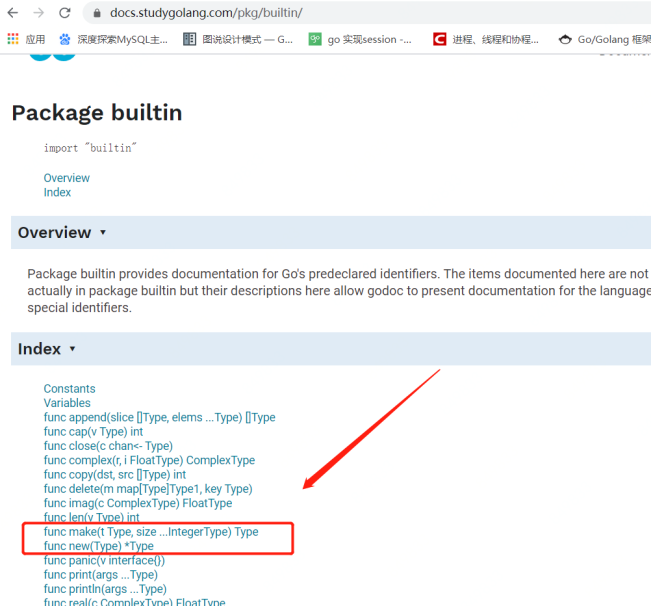жӮЁеҘҪпјҢзҷ»еҪ•еҗҺжүҚиғҪдёӢи®ўеҚ•е“ҰпјҒ
жң¬зҜҮж–Үз« з»ҷеӨ§е®¶еҲҶдә«зҡ„жҳҜжңүе…іGolangдёӯmakeе’ҢnewеҰӮдҪ•дҪҝз”ЁпјҢе°Ҹзј–и§үеҫ—жҢәе®һз”Ёзҡ„пјҢеӣ жӯӨеҲҶдә«з»ҷеӨ§е®¶еӯҰд№ пјҢеёҢжңӣеӨ§е®¶йҳ…иҜ»е®ҢиҝҷзҜҮж–Үз« еҗҺеҸҜд»ҘжңүжүҖ收иҺ·пјҢиҜқдёҚеӨҡиҜҙпјҢи·ҹзқҖе°Ҹзј–дёҖиө·жқҘзңӢзңӢеҗ§гҖӮ
еңЁgolangдёӯпјҢmakeе’ҢnewйғҪеҲҶй…ҚеҶ…еӯҳпјҢдҪҶжҳҜе®ғ们д№Ӣй—ҙд»Қ然еӯҳеңЁдёҖдәӣе·®ејӮгҖӮеҸӘжңүдәҶи§Је®ғ们д№Ӣй—ҙзҡ„е·®ејӮпјҢжүҚиғҪеңЁйҖӮеҪ“зҡ„еңәеҗҲдҪҝз”Ёе®ғ们гҖӮ
з®ҖиҖҢиЁҖд№ӢпјҢnewеҸӘжҳҜеҲҶй…ҚеҶ…еӯҳпјҢиҖҢдёҚеҲқе§ӢеҢ–еҶ…еӯҳ;makeеҲҶй…Қ并еҲқе§ӢеҢ–еҶ…еӯҳгҖӮжүҖи°“зҡ„еҲқе§ӢеҢ–е°ұжҳҜз»ҷдёҖдёӘзұ»еһӢиөӢдёҖдёӘеҲқе§ӢеҖјпјҢдҫӢеҰӮпјҢеӯ—з¬Ұдёәз©әпјҢж•ҙж•°дёә0пјҢйҖ»иҫ‘еҖјдёәfalseгҖӮ
д»ҺGolangзҡ„е®ҳж–№ж–ҮжЎЈзҡ„builtin(еҶ…зҪ®зҡ„иҪҜ件еҢ…)дёӯеҸҜд»ҘжүҫеҲ°пјҢmakeе’Ңnewзҡ„з”Ёжі•гҖӮ

newзҡ„дҪҝз”Ёд»Ӣз»Қпјҡ
жҲ‘们е…ҲжқҘзңӢзңӢnewзҡ„е®ҡд№ү
// The new built-in function allocates memory. The first argument is a type, // not a value, and the value returned is a pointer to a newly // allocated zero value of that type. //еҶ…е»әеҮҪж•°newеҲҶй…ҚеҶ…еӯҳгҖӮ其第дёҖдёӘе®һеҸӮдёәзұ»еһӢпјҢиҖҢйқһеҖјгҖӮе…¶иҝ”еӣһеҖјдёәжҢҮеҗ‘иҜҘзұ»еһӢзҡ„ж–°еҲҶй…Қзҡ„йӣ¶еҖјзҡ„жҢҮй’ҲгҖӮ func new(Type) *Type
еҸҜд»ҘзңӢеҮәпјҢе®ғзҡ„еҸӮж•°жҳҜдёҖдёӘзұ»еһӢпјҢиҝ”еӣһеҖјжҳҜжҢҮеҗ‘иҜҘзұ»еһӢзҡ„еҶ…еӯҳең°еқҖзҡ„жҢҮй’ҲпјҢ并且еҲҶй…Қзҡ„еҶ…еӯҳе°Ҷиў«и®ҫзҪ®дёәйӣ¶пјҢеҚіиҜҘзұ»еһӢзҡ„йӣ¶еҖјпјҢеҚіеӯ—з¬Ұдёәз©әпјҢж•ҙж•°дёә0пјҢйҖ»иҫ‘еҖјдёәfalse
зңӢдёҖдәӣдҫӢеӯҗ
type P struct { Name string Age int } var a *[2]int var s *string var b *bool var i *int var ps *P a = new([2]int) s = new(string) b = new(bool) i = new(int) ps = new(P) //structure fmt.Println(a, " ", *a) fmt.Println(s, " ", *s) fmt.Println(b, " ", *b) fmt.Println(i, " ", *i) fmt.Println(ps, " ", *ps)иҫ“еҮәеҰӮдёӢпјҡ
&[0 0] [0 0] 0xc0000821e0 0xc0000a409a false 0xc0000a40b0 0 &{ 0} { 0}дёҠйқўеҹәзЎҖзұ»еһӢпјҢжҲ‘们зңӢдёҖдёӢslice, map and channelзұ»еһӢжҳҜеҰӮдҪ•ж“ҚдҪңзҡ„пјҡ
//map ж“ҚдҪң var mp *map[string]string mp = new(map[string]string) //жіЁйҮҠжҺүдёӢйқўзҡ„иЎҢпјҢnew map иҝ”еӣһдёәnil,зӣҙжҺҘдҪҝз”Ёдјҡpanic //*mp = make(map[string]string) // if this line is omitted, it will pan "Pan: assignment to entry in nil map"вҖң (*mp)["name"] = "lc" fmt.Println((*mp)["name"]) // slice ж“ҚдҪң var ms *[]string ms = new([]string) // жіЁйҮҠжҺүдёӢйқўзҡ„иЎҢи®ҝй—®зҡ„ж—¶еҖҷдјҡдёӢж Үи¶…еҮәиҢғеӣҙ //*ms = make([]string,5) // if this line is deleted, it will "panic: runtime error: index out of range" (*ms)[0] = "lc" fmt.Println((*ms)[0])
д»ҺдёҠйқўеҸҜд»ҘзңӢеҮәпјҢsilceпјҢmapпјҢchannelе’Ңе…¶д»–зұ»еһӢжҳҜеј•з”Ёзұ»еһӢгҖӮеҪ“еј•з”Ёзұ»еһӢеҲқе§ӢеҢ–дёәnilж—¶пјҢдёҚиғҪзӣҙжҺҘеҲҶй…ҚnilпјҢд№ҹдёҚиғҪдҪҝз”ЁnewжқҘеҲҶй…ҚеҶ…еӯҳпјҢиҝҳйңҖиҰҒдҪҝз”ЁmakeжқҘиҝӣиЎҢеҲҶй…ҚгҖӮ
makeзҡ„дҪҝз”Ёд»Ӣз»Қпјҡ
жҲ‘们зңӢдёҖдёӢmakeзҡ„е®ҡд№ү
/ /The make built-in function allocates and initializes an object of type // slice, map, or chan (only). Like new, the first argument is a type, not a // value. Unlike new, make's return type is the same as the type of its // argument, not a pointer to it. The specification of the result depends on // the type: // Slice: The size specifies the length. The capacity of the slice is // equal to its length. A second integer argument may be provided to // specify a different capacity; it must be no smaller than the // length. For example, make([]int, 0, 10) allocates an underlying array // of size 10 and returns a slice of length 0 and capacity 10 that is // backed by this underlying array. // Map: An empty map is allocated with enough space to hold the // specified number of elements. The size may be omitted, in which case // a small starting size is allocated. // Channel: The channel's buffer is initialized with the specified // buffer capacity. If zero, or the size is omitted, the channel is // unbuffered. //еҲҮзүҮпјҡsizeжҢҮе®ҡдәҶе…¶й•ҝеәҰгҖӮиҜҘеҲҮзүҮзҡ„е®№йҮҸзӯүдәҺе…¶й•ҝеәҰгҖӮеҲҮзүҮж”ҜжҢҒ第дәҢдёӘж•ҙж•°е®һеҸӮеҸҜз”ЁжқҘжҢҮе®ҡдёҚеҗҢзҡ„е®№йҮҸпјӣ е®ғеҝ…йЎ»дёҚе°ҸдәҺе…¶й•ҝеәҰпјҢеӣ жӯӨ make([]int, 0, 10) дјҡеҲҶй…ҚдёҖдёӘй•ҝеәҰдёә0пјҢе®№йҮҸдёә10зҡ„еҲҮзүҮгҖӮ //жҳ е°„пјҡеҲқе§ӢеҲҶй…Қзҡ„еҲӣе»әеҸ–еҶідәҺsizeпјҢдҪҶдә§з”ҹзҡ„жҳ е°„й•ҝеәҰдёә0гҖӮsizeеҸҜд»ҘзңҒз•ҘпјҢиҝҷз§Қжғ…еҶөдёӢе°ұдјҡеҲҶй…ҚдёҖдёӘе°Ҹзҡ„иө·е§ӢеӨ§е°ҸгҖӮ //йҖҡйҒ“пјҡйҖҡйҒ“зҡ„зј“еӯҳж №жҚ®жҢҮе®ҡзҡ„зј“еӯҳе®№йҮҸеҲқе§ӢеҢ–гҖӮиӢҘ sizeдёәйӣ¶жҲ–иў«зңҒз•ҘпјҢиҜҘдҝЎйҒ“еҚідёәж— зј“еӯҳзҡ„гҖӮ func make(t Type, size ...IntegerType) Type
еҸҜд»ҘзңӢеҮәпјҢе®ғиҝ”еӣһзҡ„жҳҜзұ»еһӢжң¬иә«иҖҢдёҚжҳҜжҢҮй’Ҳзұ»еһӢпјҢеӣ дёәmakeеҸӘиғҪдёәsliceпјҢmapпјҢchannelзӯүеҲқе§ӢеҢ–еҶ…еӯҳпјҢ并且е®ғ们иҝ”еӣһеј•з”Ёзұ»еһӢпјҢеӣ жӯӨдёҚеҝ…иҝ”еӣһжҢҮй’Ҳ
и®©жҲ‘们зңӢдёҖдәӣmakeзҡ„дҫӢеӯҗпјҡ
mm :=make(map[string]string) mm["name"] = "lc" fmt.Println(mm["name"]) mss :=make([]int,2) mss[0] = 100 fmt.Println(mss[0]) ch :=make(chan int,1) ch <-100 fmt.Println(<-ch)
жҖ»з»“пјҡ
makeд»…з”ЁдәҺеҲҶй…Қе’ҢеҲқе§ӢеҢ–sliceпјҢmapе’Ңchanзұ»еһӢзҡ„ж•°жҚ®гҖӮnewеҸҜд»ҘеҲҶй…Қд»»дҪ•зұ»еһӢзҡ„ж•°жҚ®гҖӮnewеҲҶй…Қиҝ”еӣһдёҖдёӘжҢҮй’ҲпјҢеҚіType * TypeгҖӮmakeиҝ”еӣһдёҖдёӘеј•з”ЁпјҢиҜҘеј•з”ЁдёәTypeз”ұmakeеҲҶй…Қзҡ„з©әй—ҙд№ӢеҗҺпјҢжё…йҷӨ并еҲқе§ӢеҢ–з”ұnewеҲҶй…Қзҡ„з©әй—ҙгҖӮ
д»ҘдёҠе°ұжҳҜGolangдёӯmakeе’ҢnewеҰӮдҪ•дҪҝз”ЁпјҢе°Ҹзј–зӣёдҝЎжңүйғЁеҲҶзҹҘиҜҶзӮ№еҸҜиғҪжҳҜжҲ‘们ж—Ҙеёёе·ҘдҪңдјҡи§ҒеҲ°жҲ–з”ЁеҲ°зҡ„гҖӮеёҢжңӣдҪ иғҪйҖҡиҝҮиҝҷзҜҮж–Үз« еӯҰеҲ°жӣҙеӨҡзҹҘиҜҶгҖӮжӣҙеӨҡиҜҰжғ…敬иҜ·е…іжіЁдәҝйҖҹдә‘иЎҢдёҡиө„и®Ҝйў‘йҒ“гҖӮ
е…ҚиҙЈеЈ°жҳҺпјҡжң¬з«ҷеҸ‘еёғзҡ„еҶ…е®№пјҲеӣҫзүҮгҖҒи§Ҷйў‘е’Ңж–Үеӯ—пјүд»ҘеҺҹеҲӣгҖҒиҪ¬иҪҪе’ҢеҲҶдә«дёәдё»пјҢж–Үз« и§ӮзӮ№дёҚд»ЈиЎЁжң¬зҪ‘з«ҷз«ӢеңәпјҢеҰӮжһңж¶үеҸҠдҫөжқғиҜ·иҒ”зі»з«ҷй•ҝйӮ®з®ұпјҡis@yisu.comиҝӣиЎҢдёҫжҠҘпјҢ并жҸҗдҫӣзӣёе…іиҜҒжҚ®пјҢдёҖз»ҸжҹҘе®һпјҢе°Ҷз«ӢеҲ»еҲ йҷӨж¶үе«ҢдҫөжқғеҶ…е®№гҖӮ
жӮЁеҘҪпјҢзҷ»еҪ•еҗҺжүҚиғҪдёӢи®ўеҚ•е“ҰпјҒ